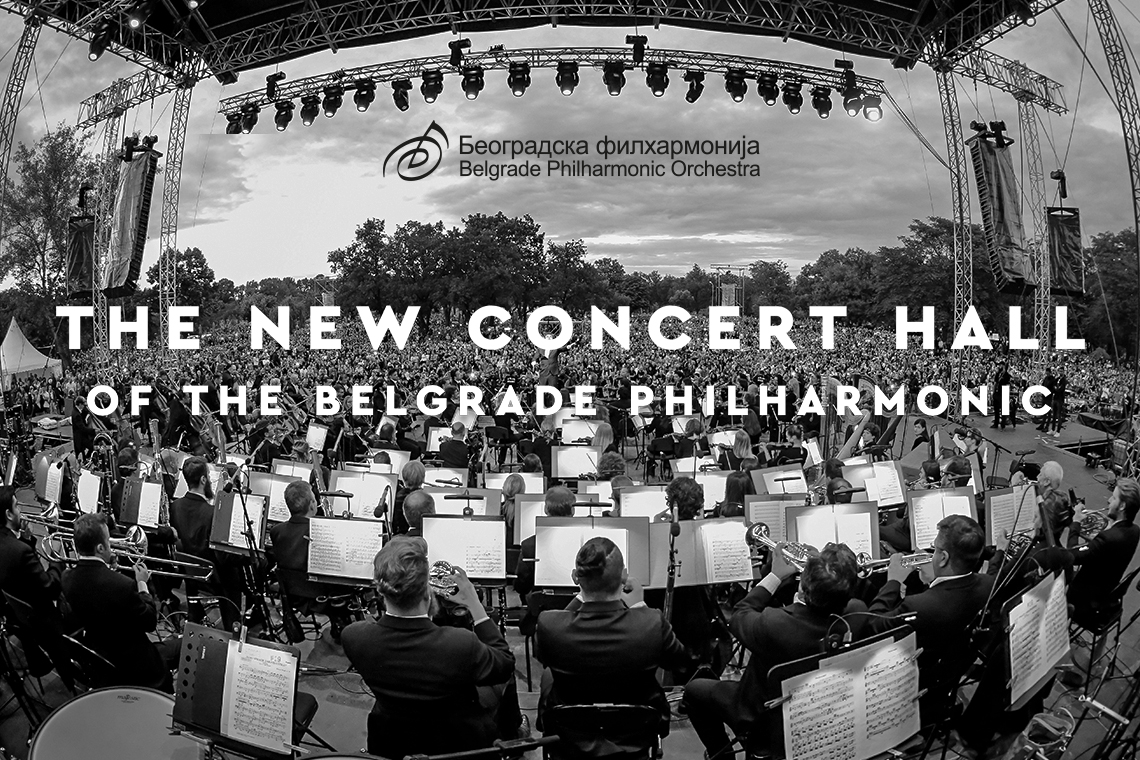
LOCATION
- What will be the location of the new Belgrade Philharmonic Concert Hall?
The Belgrade Philharmonic’s new concert hall will be located in the eastern part of New Belgrade, more precisely, in Block 13 – between the area called “Ušće” and the government building called the “Serbia Palace” – where the Belgrade Philharmonic held its open-air performances in 2017 and 2018, the biggest classical music concerts in Belgrade and Serbia. This location has been defined by the relevant Detailed Regulation Plan.
- Why has that particular location been chosen?
The location has been established by the Detailed Regulation Plan for Block 13, which was adopted by the Belgrade City Assembly. It was chosen with the vision that the Belgrade Philharmonic Concert Hall would become an internationally relevant art center, as well as a kind of hub of culture in the region. This location is suitable for a place of such artistic prominence because it is in the city center, near the confluence of the Sava River into the Danube and close to Branko’s bridge, which connects the two parts of the city. It is well connected by existing public transport lines to different parts of Belgrade and is surrounded on three sides by wide roads that connect the city with the airport.
The idea is for the Belgrade Philharmonic Concert Hall to be easily accessible to visitors and located in a place where it will be visible to everyone nearby. The building itself will be in harmony with its surrounding environment, especially with regard to the Serbia Palace and also the natural setting that makes up the park and the river. Therefore, the exterior should be made to fit into the surrounding green landscape.
VISION
- How has the Belgrade Philharmonic Concert Hall been envisioned?
The Belgrade Philharmonic’s new concert hall will be an internationally recognized center for art of the highest quality, a regional hub for cultural dialogue, and a new symbol of Belgrade and Serbia.
The concert hall will be the home of the Belgrade Philharmonic and a national music center that will bring together artists and the community in order to create, discover, and enjoy music and musical activities. It will have a multidisciplinary approach to music and a connection with other genres such as dance and visual arts, with the application of the latest technology, and will serve as a place to showcase and nurture the best that the art industry has to offer. The venue will have a multi-purpose design by providing a range of additional services that will ensure its long-term sustainability.
The Belgrade Philharmonic Concert Hall should be designed as a very accessible, interesting, and attractive place for social gathering of the inhabitants of the capital; a place that celebrates the lifestyle of Belgrade as a European metropolis.
- Who will perform at the Belgrade Philharmonic Concert Hall?
The new concert hall is intended to be a national music center under the management of the Belgrade Philharmonic and as such, it will serve to showcase other top local, regional, and international artists. The Belgrade Philharmonic Concert Hall will be the first of its kind in the Balkans.
The new concert hall will consist of several main areas:
- 1,600 seat concert hall designed to provide world-class quality for rehearsals and the performance of symphonic music;
- 400 seat recital hall for smaller concerts and rehearsals of the entire orchestra or choir, as well as for semi-staged and experimental performances;
- 100 seat studio equipped with innovative and state-of-the-art technology for performing and recording music and also to be used as a smaller concert space;
- dual-purpose podium to be used as a space for performing symphonic music and other outdoor performances, with a capacity of 20,000 seats in the park, and as a space for other artistic content, such as exhibitions and commercial-type events.
In addition to these main areas, the building will also have all the necessary ancillary facilities.
- Why does the Belgrade Philharmonic need a new hall?
The Belgrade Philharmonic is housed in a temporary venue built in 1967 and renovated in 2004. Since this renovation was done within the existing dimensions, the building is not conducive for the work and further development of the Belgrade Philharmonic. The hall has only 200 seats, there is no room for practice or storage of instruments and equipment, the administration staff does not have adequate working conditions, etc. Director Ivan Tasovac took over the Belgrade Philharmonic in 2001 and initiated a period of improvement of the general functioning of this institution, the quality of the orchestra and the audience, creating an increased public interest and positioning the Belgrade Philharmonic firmly on the musical map of Europe and the world. The concert seasons held at the Kolarac Music Hall soon became completely sold out due to the quality of the orchestra as well as the numerous activities and tools that contribute to developing a more discerning audience. Having in mind the limitations of the Kolarac Hall and the fact that Serbia does not have a single adequate symphony concert hall, the building of this music venue is defined as a key priority for the further development of the orchestra and the musical and cultural life of Serbia, as well as being the biggest project of sustainable development of culture in the region.
PROJECT PARTICIPANTS
- Who are all the participants in this project?
The participants are the Government of the Republic of Serbia (Office for Public Investment Management, the Prime Minister’s Office and the Ministry of Culture), the UNDP, the Arup Group, the City of Belgrade, and the Belgrade Philharmonic.
- What is the UNDP’s role in this project?
The UNDP has been hired by the Government of Serbia to assist in organizing the international tender for the architectural design of the concert hall. The UNDP has offices in 170 countries and a large partner network that contributes to attracting world-renowned architectural bureaus with experience in projects of this size and complexity as well as the expertise necessary to incorporate social, economic, and environmental aspects into the concert hall’s architectural design.
- How was the Arup Group selected and what was their role?
Responding to the Government’s request, and after conducting a competitive procurement process, in 2017 UNDP hired the Arup Group, which prepared a feasibility study for the new concert hall in 2019.
Arup is one of the world’s leading engineering companies, which in its history of over 70 years has implemented more than 250 projects in the field of acoustic design and more than 30 projects in the field of design of concert, theater, and other halls. Arup has been engaged on the basis of its extensive experience in defining needs but also designing concert halls, theaters, and facilities of similar size and purpose. Some of their projects include:
- Barbican Center London, UK
- Sydney Opera House, Australia
- Harpa Concert Hall and Conference Center in Reykjavik, Iceland
- La Maison Symphonique, a concert hall in Montreal -Quebec-Canada
- National Forum of Music – concert hall in Wroclaw, Poland
In addition to the aforementioned feasibility study, Arup also provides advisory services related to the organization of tenders and design tenders. It also participates in selecting the architectural design company, but it will also revise and advise the selected company in its development of the conceptual design, construction permit project, and construction project.
FEASIBILITY STUDY AND COMPETITION
- What did the process of preparing the feasibility study look like and who are all the participants?
The representatives of Arup came to Belgrade before starting work on the feasibility study to gain an insight into the cultural life of Belgrade and Serbia. Together with the representatives of the Belgrade Philharmonic, they visited the Music Production Department of the RTS (Serbian Radio Television), the FMU (Faculty of Music Arts), the National Theater, the Music Youth (Jeunesses Musicales) and talked with the representatives of the SMU (Union of Music Artists) and the employees of the Belgrade Philharmonic in order to better understand the needs that the new concert hall would be required to fulfill, not just for the Belgrade Philharmonic but also for Belgrade and Serbia.
Participants in preparing the feasibility study, apart from Arup Group, also included representatives of the Belgrade Philharmonic, the Office of the Prime Minister of the Republic of Serbia, the Public Investment Office, and the City Architect in and advisory role.
- Why was it estimated that the concert hall needs to have 25,000 square meters of area?
The estimated total area of the concert hall is the result of the feasibility study conducted by Arup during 2018 and 2019. The study stipulates that the building of the Belgrade Philharmonic should consist of several rooms for different purposes, such as rehearsals and performances, but also for educational and commercial contents, as well as all the necessary accompanying space. The assessment of the area of the building was influenced by the estimated number of people who should be in the building at a given time (e.g. the number of seats in the auditorium or the number of people in the lobby), as well as the area of additional rooms typical for such a venue (e.g. space for storage of technical equipment). The technical specifications for the architectural design solutions of this building are in line with the best examples of international practice.
- What are the necessary UNESCO/UNDP procedures in this process and how do they differ from the usual competition rules of this type?
The procedure for this competition is being carried out in accordance with UIA (International Union of Architects)/UNESCO guidelines and local regulations. It differs from the “usual” competitions for architectural solutions, because it is not open for submission of solutions but is open for prequalification. This type of competition was chosen taking into account the specifics of the venue, its complexity and significance, both from a financial and artistic aspect.
The model with prequalification and awarding of the contract to the winner of the competition was chosen as appropriate and in accordance with the UIA guidelines, which stipulate prequalification as a legitimate method of competition. Prequalification means choosing between 6 and 8 companies that will participate in the preparation of the architectural solutions for the concert hall in the next project phase. The UNDP will conclude a contract with the prequalified company whose solution is judged to be the best. This process allows only those companies with the knowledge and capacity necessary for the preparation of complete project documentation to participate in the architectural competition.
The continuity of project execution from concept to complete development is important for this type of building because it ensures the best quality of the project.
- Who will comprise the panel of judges that will choose the winning solution?
The panel of judges will consist of international, regional, and local experts from fields relevant for this project.
- When could the construction of the new concert hall be expected to be completed?
The selection of the conceptual design and the award of the contract will be followed by the architectural design process. The planned deadline for the completion of the design, which includes technical control, is the end of 2022 or early 2023. After that, construction could begin, requiring a minimum of between 3-5 years with equipment.
- Why do some media mention the “failed” 2017 competition for the Philharmonic building?
Certain media have incorrectly reported that a competition for the new Belgrade Philharmonic building was announced in 2017 but was allegedly unsuccessful because no conceptual solution was chosen for the new building. The fact is that the 2017 competition was a survey competition for an architectural solution for not just the concert hall but for the entire urban area in Block 13, including the Serbia Palace and an additional residential block. The survey competition was successfully concluded and served as a basis for developing and adopting the Detailed Regulation Plan for that part of Block 13 (PDR).
- Why are there different names for this project?
In the documentation that accompanies this project, there are several working names, such as the Concert Hall of the Belgrade Philharmonic, the New Building of the Belgrade Philharmonic, the National Concert Hall and the Belgrade Concert Hall. This is the same capital project for the new concert hall, which will be the home of the Belgrade Philharmonic and under its management.
BUDGET
- How much did the feasibility study cost, what did it cover, and who will pay for it?
The feasibility study is a set of documents that cover all the different aspects of the concert hall and that were developed in sequence. This means that all the relevant government institutions were involved in each step of the development of the study and that the Arup Group moved on to the next phase of the study only after their approval.
The feasibility study includes: justification and objectives of the project, program-spatial analysis with a conceptual proposal of architectural and technical solutions, an analysis of the proposed location and an analysis of the building’s estimated value.
All parts of the feasibility study have been done in consultation and discussion and with the approved of the Serbian Government, the Office for Public Investment Management, the Chief Planner of the City of Belgrade, and the Belgrade Philharmonic.
The parts of the feasibility study prepared so far have cost $527,465 and the funds were provided by the Serbian Government, which adopted the feasibility study in 2019.
- How much will the chosen solution cost and how will that cost be paid?
The maximum budget amount for the project of the winning solution, i.e. for the preparation of technical documentation that will be entrusted to the author of the winning solution, is $ 10,230,000.
- How much will it cost to carry out the project?
Based on the cost estimate given by Arup’s feasibility study, the Serbian Government has allocated 120 million euros for this project.
SIGNIFICANCE
- How will the Belgrade Philharmonic Concert Hall contribute to the country’s a) social, b) economic and c) ecological development?
-
- a) The Belgrade Philharmonic Concert Hall will improve the quality of life of the citizens of Belgrade and Serbia:
- Citizens will have a new, adequately large space to enjoy music and other related cultural events.
- Citizens will have a new space for gathering and meeting, which can contribute to strengthening social cohesion.
- There will be a new place for contacts, interaction, and exchange of knowledge, ideas and experiences with artists and other professionals from abroad.
- Inclusiveness: the Belgrade Philharmonic Concert Hall will be a space for social gatherings, open 24 hours a day, 7 days a week, for a variety of contents and for all citizens. The building itself should be an easily visible and attractive space, which will evoke in visitors a sense of belonging and attract them to stay in it. It is also important that this hall will be open during the day, which will make the programs and facilities it offers easily accessible to citizens who have a habit of spending their free time in the surrounding park. In order for the building itself to be accessible for the widest circle of users and visitors, the architectural solution will have to provide, in accordance with the best international practice, equal access to everyone regardless of age, disability, gender, cultural, or social origin, or other personal circumstances.
- The concert hall will be a place open to many music professionals and music lovers, providing space for practice, rehearsals, workshops, discussions and learning, and many rooms will have multiple purposes. It will offer musical performances of a high standard to a wider audience, but also other activities in order to be relevant for all citizens. A series of spaces for different purposes inside the concert hall and in its exterior will provide everyone with the opportunity to engage in music: young and old, professionals and amateurs, local and international artists. The common public space is modeled on the town square, where artists and other citizens will be able to meet throughout the day. In addition to the cultural program, visitors will be able to spend time at this place consuming various contents.
- b) Given its concept as a center of an international level of musical excellence, it is expected that:
- The new Belgrade Philharmonic Concert Hall has an expected income from foreign tourists as well as domestic visitors. Belgrade will get a concert hall as a new landmark representing the capital and the country abroad, much like the Sydney Opera House.
- It will serve to stimulate economic growth and development through investments in innovations and infrastructure.
c) The facility should be energy efficient, use clean “green” energy, have close to zero greenhouse gas (GHG) emissions and not contribute to air pollution. The Plan of Detailed Regulation (PDR) calls for the maximum protection of green areas (trees): the loss of green area capacity, caused by the newly planned solution, must be compensated by planting quality woody vegetation, in a ratio of two new trees for every tree cut down.wo new trees for every tree cut down.






